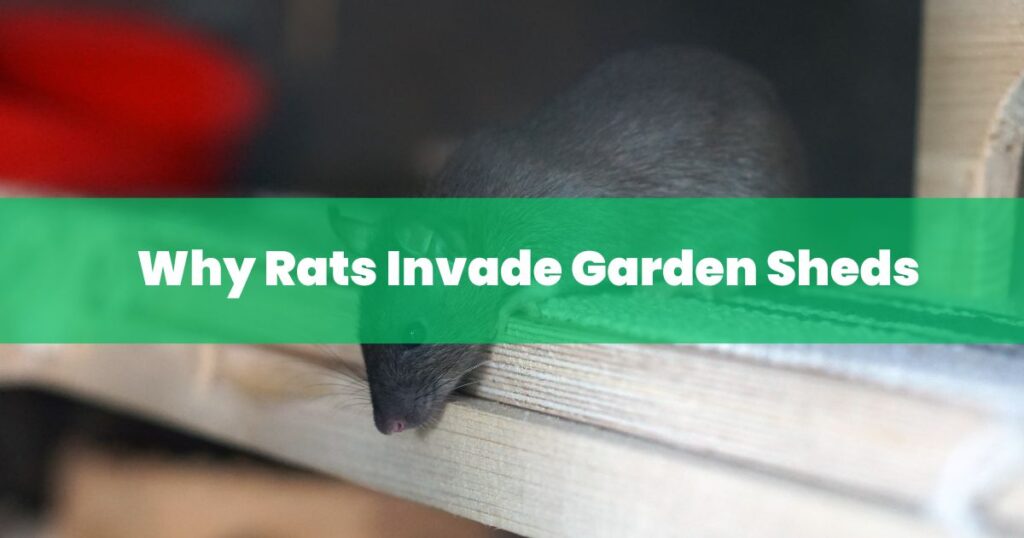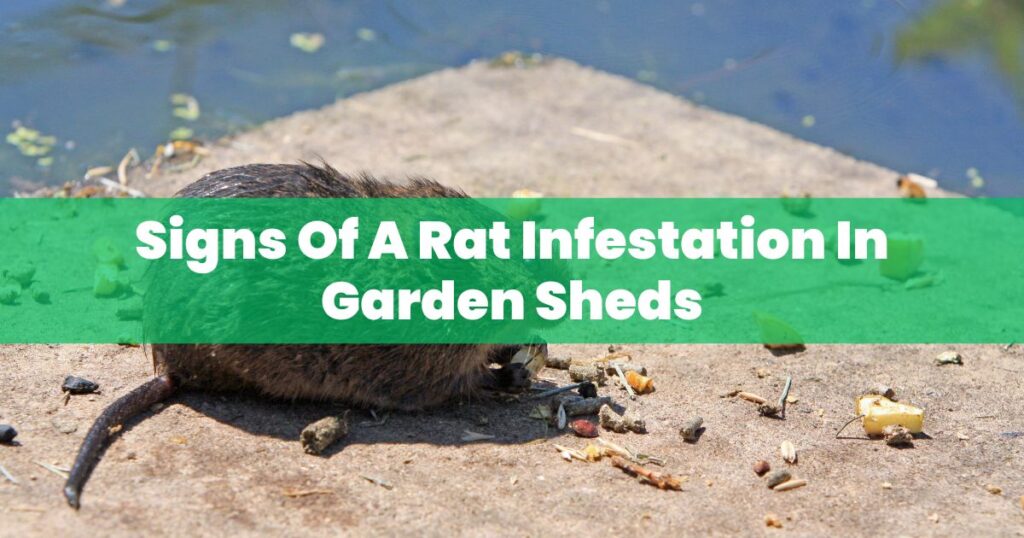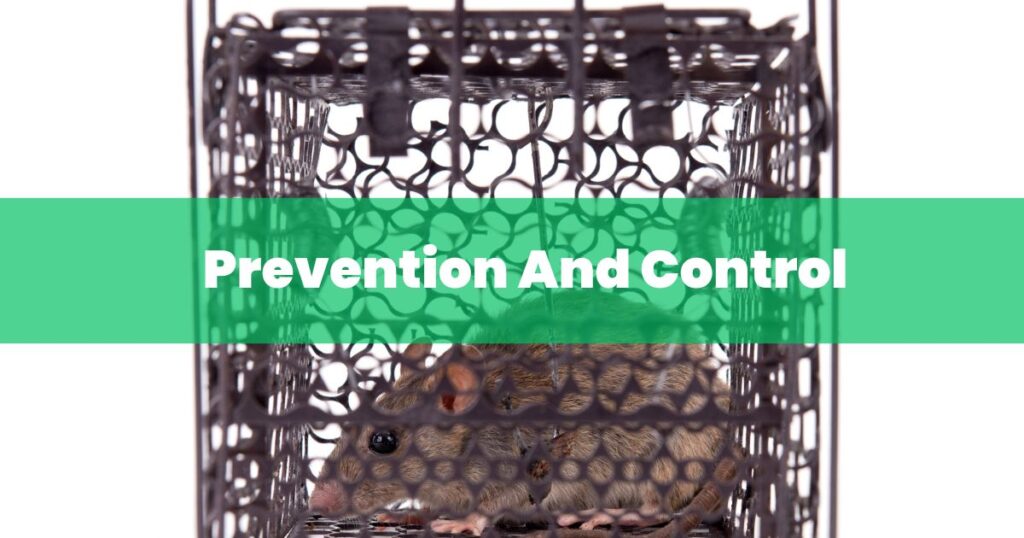Last Updated on June 30, 2023 by Dale Allan
If you having a problem with rats in your garden shed this article is for you!
I’ll dig deep into the ways to get rid of rats from your shed.

Why Rats Invade Garden Sheds
There are few factors why rats are in the garden shed. Those factors include: availability of food sources, protection from predators and weather, access to water sources, and potential nesting sites.
Availability Of Food Sources
As gardeners, you should be aware that rats are attracted to availability of food sources in garden sheds.
Unsecured food or bird feeder can provide an easy meal for a rat without having to search far.
Common food items include bulbs, swollen stems, seeds, ripe fruit and root vegetables such as potatoes, carrots, beetroots, corn cobs pumpkins and squash.
They can also feed on well-stored fruits and vegetables either inside the shed or in your vegetable patch.
To discourage rats from taking up residence in your shed it is important that all potential sources of food are removed leading them to explore elsewhere for sustenance.
Perhaps one of the easiest ways to remove potential scraps is keeping your yard or garden clean by cutting back overgrown areas regularly and ridding any piles made by leaves etc.
Protection From Predators And Weather
Having a garden shed in your home is great – they provide a secure space where you can store tools and supplies away from the elements. Unfortunately, these same features that make sheds so attractive to us also make them an ideal place for rats seeking protection from predators and weather.
That’s why it’s important to take preventative measures when protecting your garden shed against rat infestations.
Regular cleaning and removal of clutter is essential here – mice and rats are incredibly adept at spotting potential nesting sites amongst piles of wood, fabric, or cardboard boxes that might have been left lying around too long.
You should also take steps like blocking all possible entry points (which could range from holes the size of half a centimetre up) before securing shut unused air vents with wire mesh screens or caulk sealant;
Access To Water Sources
A big factor in why rats will choose to reside in your garden shed is the availability of water.
Rats need access to water daily and can therefore be attracted to sheds near sources of running water or natural reservoirs such as ponds.
This could explain why they might chose your shed over another if it has an open pipe nearby, for example.
It’s important then to pay special attention when preventing rat infestations, by not just looking into where food may have been left but making sure there are no leakage, standing pools of water or other wet places which may provide them with a source of hydration and possible sustenance inside or around your shed area.
Make sure you check the surface close to the ground, rats also like to look for a water there.
Potential Nesting Sites
Areas of concern for rat infestations include wood piles, piles of leaves or grass clippings, underneath compost heaps, inside equipment storage areas such as gazebos, roof voids and wall cavities along garden buildings.
Other potential nesting sites outside a shed include rockeries and flowerbeds due to their insulation materials which provide warmth during cooler seasons.
It is important to inspect these potential nesting spots regularly for any rodent activity such as droppings, gnaw marks on cables or wires, burrowing near entry points or smells coming from within the walls.
Additionally keeping grills firmly fixed over sewer vents will prevent rats using them as entryways into the shed.

Signs Of A Rat Infestation In Garden Sheds
Look out for gnawed cables, wood, and materials; droppings and urine stains; unpleasant smells and scratching noises; as well as nests or burrows.
Gnawed Cables, Wood, And Materials
Rats are persistent and cunning when it comes to finding food sources. When they find their way into your garden shed, among the wires and stored items, rats can quickly chew through cabling insulation or gnaw on wooden structures like wall panels.
This often results in electrical fires if exposed wires short out and flooding if pipes become damaged along with other more serious safety hazards.
It’s important to take steps to prevent rats from damaging wood and wiring inside your garden shed by keeping them sealed in metal bins when not used, which will also protect against corrosion build up due to rat droppings.
Inspect cables for signs of damage such as bite marks regularly, either during scheduled maintenance or every time you use the material/item that has been stored away in its designated storage place/bin/drawer etc.
If possible, try to store vulnerable materials away from areas that might attract rats such as birdfeeders – Rats love birdseed!
Additionally Peppermint oil is a natural repellent that is known to keep rodents at bay; consider placing some around trouble spots like doorframes prone to invasion.
Droppings And Urine Stains
One of the surest signs that a rat has been in your garden shed is seeing their droppings or urine stains.
Not only are these unsightly, but they can also be contaminated with bacteria and viruses which may cause illness.
When confronted with this issue, the most important thing is safety – get yourself a pair of gloves and disposable masks as well as an antibacterial solution such as bleach to clean up the mess safely.
You should then discard all materials used for cleaning separately into a sealed plastic bag so its contamination doesn’t spread elsewhere in your yard.
Unpleasant Smells And Scratching Noises
One of the most obvious indications of a rat infestation is unpleasant smells and scratching noises as rats secrete urine as they move, creating a musky smell around their home.
Additionally, you may hear scraping and gnawing sounds coming from your shed at night.
It is key to recognize these signs promptly in order to limit any damage or health risks posed by an infestation in your garden shed.
Nests And Burrows
Rats may use wood chips, shredded paper and other materials to form nests in dark corners or behind furniture, as well as digging burrows for shelter and hiding food.
You’ll also want to look out for any holes outside – such as gnawed through brickwork or siding – where rodents might be entering.
Make sure all access points are sealed off securely with wire mesh or suitable materials; cover ventilators with flyproof grills if necessary. If an infestation persists despite your best efforts then consider engaging a professional pest control service specialized in rodent management.

Prevention And Control Methods For Rat Infestations In Garden Sheds
Regular cleaning and addressing clutter, blocking entry points, eliminating food sources and using traps/bait stations are all effective methods of preventing rat infestations in garden sheds.
Regular Cleaning And Removal Of Clutter
Regularly cleaning and removing clutter from garden sheds is essential for preventing rat infestations. Leftover food, debris, and other sources of shelter provide a perfect place for rats to hide and breed.
Removing all traces of food or drink from the shed is key in deterring them from visiting in the first place.
It’s also important to regularly inspect your shed for any gaps or holes that could provide an entry point for rodents so they can get inside. Finally, eliminating potential nesting materials such as stacks of old clothes or newspapers can help keep rats at bay.
Blocking Entry Points
It is important to block rat entry points in and around your garden shed. Rats can fit through surprisingly small gaps, so inspect your shed carefully for any hole that’s roughly the size of a ballpoint pen or larger – these should be sealed with heavy-duty caulking.
Pay special attention to crevices near pipes as well; rats may want access to water inside them! You may also want to add a metal ‘kick plate’ beneath the door of your garden shed, which will serve as an additional barrier against rodents.
Don’t forget about roof. Any, even tiny, hole in a roof might invite rats.
Eliminating Potential Food Sources
One of the best ways for gardeners to keep rats out of their garden shed is to eliminate potential food sources. This means regularly cleaning up any animal food, bird seed, or general gardening waste that may be lying around the area.
It’s important not to simply leave this debris behind as it can easily attract rodents by providing them with an easy source of nutrients. Additionally, when disposing of organic materials such as kitchen scraps and fruit peels, it’s essential to compost any waste properly in fully covered bins so that they are less likely to attract pests.
When storing pet or bird food outdoors, always ensure that you use metal cross-latching containers instead of plastic bins – rats can chew through these relatively easily and make short work of your pantry items!
Using Traps And Bait Stations
One of the best ways to get rid of rodents is by setting traps and bait stations. Trapping works well if used correctly, but it’s important to read all instructions carefully beforehand.
Bait boxes and various tamper-proof rodenticides are available for controlling rats outdoors as an alternative to killing them directly with a snap trap inside the shed.
Natural Deterrents, Such As Peppermint Oil
Peppermint oil can be effectively used to keep rats away from garden sheds. Its strong, minty smell disrupts the rat’s sense of smell and they are unable to remain in such an environment.
It is most effective when sprayed directly onto objects and points of ingress that rats would typically enter from – such as doors, vents or any holes in walls – but won’t cause any damage if left for long periods either indoors or outside.
All in All
Hope this guide on keeping rats in the garden away from your shed was helpful.
Thanks for reading.
Dale
Hey, I’m Dale, I live in Scottish Highlands with my family where we looks after our farm and do some DIY projects together with my two sons.
I love to share my knowledge about putting up sheds (I owned 3 already and helped all my pals with theirs). Hope you find my writing helpful.

